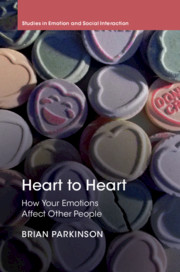Book contents
- Heart to Heart
- Studies in Emotion and Social Interaction
- Heart to Heart
- Copyright page
- Dedication
- Contents
- Figures
- Preface
- Acknowledgements
- Chapter 1 What’s at the Heart of Emotions?
- Chapter 2 Words and Concepts
- Chapter 3 Facial Activity and Emotion Expression
- Chapter 4 Explaining Emotional Influence
- Chapter 5 Regulating Emotions
- Chapter 6 Social Functions
- Chapter 7 Groups, Teams and Crowds
- Chapter 8 Working with Emotions
- Chapter 9 Reorientation
- References
- Index
- Studies in Emotion and Social Interaction
Chapter 6 - Social Functions
Published online by Cambridge University Press: 28 October 2019
- Heart to Heart
- Studies in Emotion and Social Interaction
- Heart to Heart
- Copyright page
- Dedication
- Contents
- Figures
- Preface
- Acknowledgements
- Chapter 1 What’s at the Heart of Emotions?
- Chapter 2 Words and Concepts
- Chapter 3 Facial Activity and Emotion Expression
- Chapter 4 Explaining Emotional Influence
- Chapter 5 Regulating Emotions
- Chapter 6 Social Functions
- Chapter 7 Groups, Teams and Crowds
- Chapter 8 Working with Emotions
- Chapter 9 Reorientation
- References
- Index
- Studies in Emotion and Social Interaction
Summary
A central function of many emotions is to influence other people. Indeed, people often engage in emotion regulation precisely to modify or extend the interpersonal regulatory functions that emotions already serve. This chapter focuses on these regulatory functions, and on how emotions acquire them in the first place. According to social functional theories, emotions play a role in achieving interpersonal goals relating to affiliation, interpersonal distance, dominance, or appeasement. Supporting this account, many socially oriented emotions are directly attuned to their actual and anticipated interpersonal consequences. Emotions not only communicate appraisals and relational orientations, but also provide more direct incentives and disincentives that motivate other people’s responses or prompt their cessation. Emotion components such as facial and bodily movements serve social functions too, either by communicating information, or by cuing adjustments in attention and action more directly. Although natural selection contributes to the development of many of these functions, emotions only consolidate into integrated strategies of social influence over the course of socialisation and enculturation.
- Type
- Chapter
- Information
- Heart to HeartHow Your Emotions Affect Other People, pp. 215 - 240Publisher: Cambridge University PressPrint publication year: 2019



